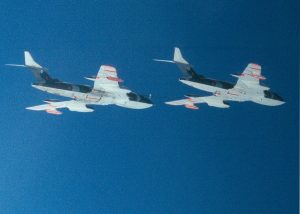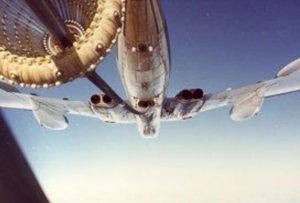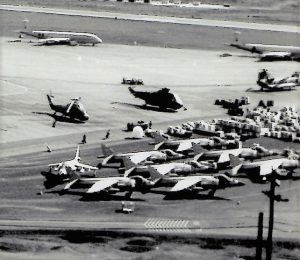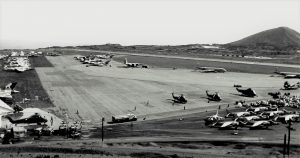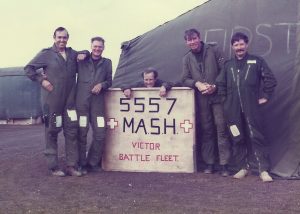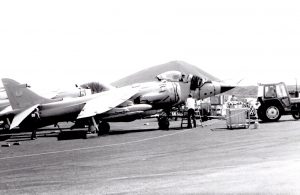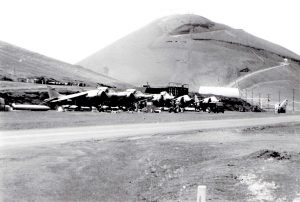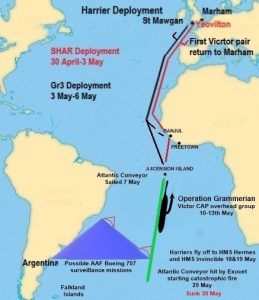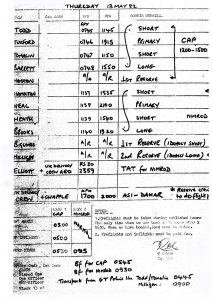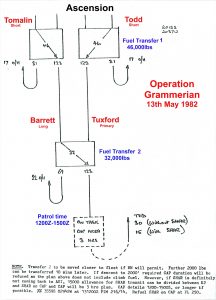In this, the first of two articles by Mike Beer, we cover the story of how Harrier reinforcements were deployed from the UK to HMS Invincible and HMS Hermes whilst operating in the South Atlantic. (Thanks to Dave Davenall for a selection of photos and refuelling plans)
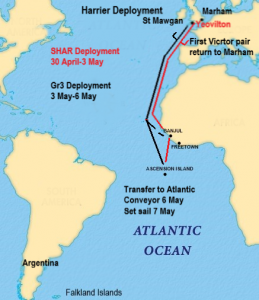
On 2nd April 1982 Argentina landed commandos near Stanley and the invasion of the Falkland Islands had begun. The UK government was quick to respond signalling their intent to recapture the islands by assembling a naval Task Force. The Carrier Battle Group swiftly set sail, departing Portsmouth on 5th April with twelve Sea Harrier FRS 1s (SHARs) embarked on HMS Invincible and 8 embarked on HMS Hermes- Nos 800 and 801 Naval Air Squadrons (NAS) respectively. Additional vital stores would be flown to Ascension Island and transported to the group when within range. This would include 8 additional SHARs of the newly reformed No 809 NAS, taken from the training unit and stored spares, and ten RAF Harrier GR3s of No 1 Squadron. These aircraft were to be flown from UK bases to Ascension Island using Victor K2 air to air refuelling tankers based at RAF Marham. The Harriers would then be landed vertically on MV Atlantic Conveyor which would sail south and transfer them to the Carrier Battle Group.
The Harrier movement plans, named Hawk Trials, were prepared by the Air to Air Refuelling Plans section at Headquarters No 1 Group, RAF Bawtry but had to be based on the small number of Victor tankers remaining at RAF Marham. Fifteen tankers and fourteen crews were already deployed to Wideawake Airfield in support of impending Black Buck 1 and 2 bombing missions scheduled for the 30th April/1st May and 3rd/4th May. Therefore the Harrier deployment had to be shuttled over six days using the small number of available tankers. The UK tanker crews were drawn from the instructors of No 232 Operational Conversion Unit topped up with students midway through their air conversion when hostilities commenced. These had been retained to meet the UK operational task to train Victor, Vulcan, Nimrod and Harrier pilots in AAR. The 8 SHARs were deployed over the period 30th April to 2nd May staging through Banjul, Gambia. The ten GR3s, with larger external ferry tanks, were planned to be ferried direct to Ascension over the period 3rd to 5th May. Up to four Victor tankers were used each day but successive launch days relied on sufficient tankers returning to Marham to enable each subsequent deployment.
SHAR Deployment
30th April. Six SHAR of 809 NAS (airframes XZ458, XZ491, ZA174, ZA176, ZA190, ZA194) took off from Yeovilton to rendezvous with four Victor tankers from Marham to deploy to Ascension via Banjul. The SHAR were fitted with external 100 gallon ferry tanks and bolted on refuelling probes.
The two lead Victors passed fuel to the other two off Lands End and returned to Marham. The formation split into two sections, a tanker and three SHARs. Refuelling of the SHARs was frequent using the Mark 20B wing hoses on the long sea leg to ensure each maintained sufficient fuel reserves for any en-route emergency diversion. A classic “little but often” plan. The aircraft landed at Banjul, turned round, refuelled and night stopped.
1st May. The six SHARs took off from Banjul in company with both Victor tankers, which, after completing the fuel transfers, returned to Banjul. The SHARS safely landed at Ascension.
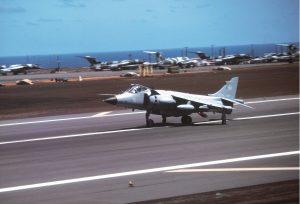
At the same time the two remaining SHARs (XZ499, ZA177) departed Yeovilton to rendezvous with a pair of Marham Victor tankers who, as the day before, conducted mutual refuelling in the same area. After refuelling, the tanker departed to return to Marham, and the formation of one Victor and two SHARs continued on the same route and refuelling plan as the previous day to land at Banjul. There were now three Victor tankers at Banjul.
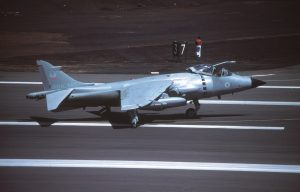
2nd May. The SHAR pair supported by a Victor tanker departed Banjul for Ascension. The plan was for the Victor to complete the refuelling, cast the SHARs off to Ascension and return to Banjul to refuel. All three Victors would then return to Marham that day to set up for the GR3 deployment. Unfortunately the fuel transfers did not go according to plan and the Victor accompanied the pair to Ascension. All landed safely. The two Victors in Banjul returned to Marham.
3rd May. The Victor returned to Marham to set up for the No 1 Squadron GR3 deployment.
Each SHAR pilot flew a total of nine hours over the two day deployment taking on fuel fourteen times from the Victor tankers.
It is also noteworthy that whilst the main SHAR deployment to Banjul was in progress over the period 30th April/1st May Ascension launched seventeen Victors and two Vulcans on Operation Black Buck 1, eleven in the outbound wave and six in the recovery of the Vulcan and a Victor.
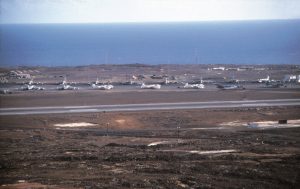
RAF Harrier GR3 Deployment.
The ten GR3s deployed forward to RAF St Mawgan, Cornwall from the 2nd May. They were fitted with two 330 gallon ferry tanks, an increase in fuel capacity which would allow a transit of 4600 miles to Ascension without the need for an intermediate landing.
3rd May. Four GR3s took off at 0930Z to rendezvous with three Victor tankers at 25,000 feet. The Squadron Commander, Wing Commander Peter Squire in XV789, Flight Lieutenants Tony Harper in XZ792, Mark Hare in XZ989 and John Rochfort in the airborne spare, XZ787. The usual fuel transfers took place off Lands End and, when completed, the spare GR3 returned to St Mawgan and two Victors to Marham. There had been a problem during the Victor-Victor fuel transfer and the long range Victor did not have sufficient fuel to ferry all three GR3s to Ascension direct. The formation leader, Squadron Leader Dave Foulger, OC 232 OCU, replanned. Two GR3s would be refuelled as planned to land at Ascension, but one, Wing Commander Squire, would have to stage through Banjul accompanied by the tanker. Both landed safely, the aircraft were quickly turned round and refuelled to continue on that same day to Ascension, landing at 2215. After a long day, three GR3s were at Ascension, albeit Wing Commander Squire had been in the cockpit for 9 hours 15 minutes!!
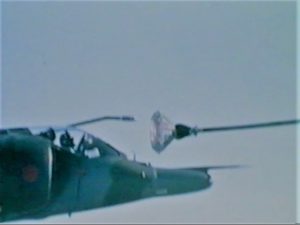
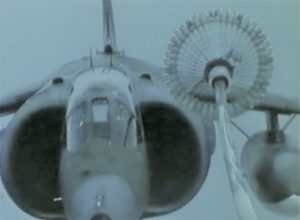
4th May. Using the same movement plan the four GR3s left St Mawgan to rendezvous with 3 Victors and after the initial fuel transfers, two Victors and the reserve GR3 returned to their mounting bases. En route Flight Lieutenant John Rochfort in XV787 experienced engine problems and diverted to Porto Santo, Madeira. Squadron Leaders Bob Iveson and Jerry Pook, in XZ963 and XZ997, landed safely at Ascension. During the day, Dave Foulger returned to Banjul.
5th May. The remaining four GR3s took off from St Mawgan and, using the same movement plan, met the three Victors from Marham. Squadron Leaders Pete Harris and Tim Smith with Flight Lieutenants Jeff Glover and Ross Boyens deployed in airframes XW919, XZ129, XZ988 and XZ132. Ross Boyens in XV132, diverted to Banjul, the others landed safely at Ascension.
6th May. Ross Boyens flew Banjul to Ascension. Nine GR3s were now at Ascension. XV787 at Porto Santo returned to the UK taking no further part in the deployment.
Throughout the eight days of deployment, Nimrod MR2 aircraft provided SAR cover of the northern segment of the route from St Mawgan and the southern segment from Freetown, Senegal.
During this deployment, over the period 3rd/4th May, Ascension also launched eleven Victors and two Vulcans on Operation Black Buck 2 with a further 5 Victors in the recovery wave.
The Move to Join the Carrier Battle Group.
The ferry fuel tanks were removed from all aircraft during post flight servicing on Wideawake. On the 6th May the eight SHARs were flown from Wideawake airfield, and after a short systems check, landed on the MV Atlantic Conveyor anchored in Georgetown Harbour, Ascension. This was followed by the 6 GR3s.
The airframes were bagged in large rubberised bags providing excellent protection for the open deck transit south. Three GR3s (XW919, XZ129 and XZ132) were retained on the airfield, fitted with Sidewinder missiles and placed on alert to defend this vital hub from air attack. Subsequently, XZ132 developed a serious fuel leak which necessitated its return to the UK, taking no further part in operations. Atlantic Conveyor sailed on the 7th May as part of the Amphibious Group, along with the assault brigade on board MV Canberra. Most pilots were accommodated on the ferry, Norland.
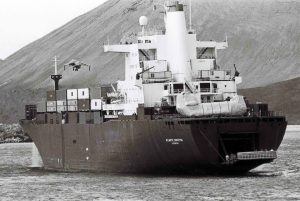
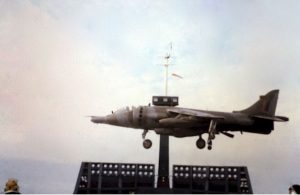
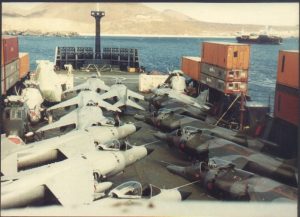
During the earlier transit of the Task Force, the Argentine Air Force Boeing 707 had been intercepted whilst flying surface surveillance of the force on the 21st, 22nd and 23rd April. The aircraft flew from its deployed eastern base at Ezeiza and flew a triangular route at 40,000 feet with legs to Ascension and South Georgia. It conducted surface surveillance using its weather warning radar, radioing reports of contacts back to Argentina. It had been intercepted by SHARs of the Carrier Group on several occasions, once closing to within five miles of the Task Force. The Argentine authorities had been warned through diplomatic channels that any further reconnaissance aircraft would be shot down. In case the 707 attempted to close the Amphibious Group on its southerly transit, one SHAR had not been protectively bagged but equipped with Sidewinders and held at readiness on the helicopter landing deck of the Atlantic Conveyor for a vertical take off.
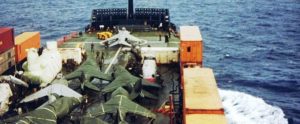
If scrambled to intercept, the SHAR, on its performance limits, would have to be recovered to Ascension. This would require Victor tanker support and the plan was named Operation Grammerian. Victor mutual fuel transfers were required to maintain a Victor overhead the Amphibious Group, where the Canberra stood out as “the white whale”. Victor sorties in support were flown on the:
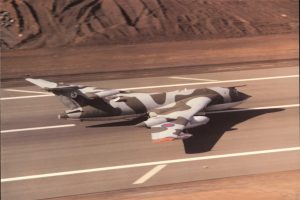
10th May. Two Victors launched and conducted refuelling south of Ascension. The primary Victor joined the Amphibious Group at position 2050S 2135W descending to 25,000 feet overhead the group to racetrack in case of a SHAR launch. The 809 Squadron SHAR on Atlantic Conveyor was brought to 5 minutes readiness to launch for a possible interception but stood down again.
11th May. The Amphibious Group was now further south and the requirement was to be on task at 3135S 2725W to provide coverage between 1200Z and 1700Z. The task required 4 Victors to launch. Mutual refuelling took place south of Ascension and 2 Victors continued south. A final Victor-Victor fuel transfer occurred and the primary continued on to the tasked area.
Again on 11th May the readiness state was increased to five minutes, then the scramble was ordered. However, the order was subsequently cancelled as there was a possible identification problem between the 707 and a Soviet Long Range Air Force Bear F in the same area. As this was in international waters, the Bear could not be intercepted, unlike the many occasions in the UK Air Defence Region where these intercepts by the QRA force were routine.
12th May. The Task Group had moved further south and the on task time-1200z-1700z- required two tanker waves to cover the on task time.
13th May. The on task position was further south at 3559S 2943W but the tasking conflicts at Ascension had reduced the numbers of Victors available for Operation Grammerian and consequently the available On Task time was reduced. Four Victors launched to provide the air patrol support, with a three hour task coverage. The short range Victors refuelled the other two who then continued south for a final transfer to the primary. The primary, Bob Tuxford, Glyn Rees and Mike Beer in XH672, were on task between 1200Z and 1500Z and airborne for 11 hours 50 minutes.
Tanker tasking was becoming critical and hard put to meet all requirements. Commencing on 9th May and continuing throughout Operation Grammerian Victors were also supporting Nimrod MR2P surveillance sorties and Hercules C-130 air drops using air to air refuelling. Additionally, a Vulcan was en route from the UK for Black Buck 3 and required a standby tanker. Consequently, the 13th May was the final Operation Grammerian support.
18th May. Atlantic Conveyor and HMS Hermes were in close proximity and the Harriers were prepared for transfer. Four SHAR (XZ499, ZA176, ZA177 and ZA194) took off vertically to land on Hermes. They were later followed by ZA190 (Lieutenant Commander Tim Gedge) which transferred to HMS Invincible. It had been planned to fly off the six GR3s the same day, but only 4 were serviceable at launch. XZ972, (Wing Commander Peter Squire), XZ988 (Squadron Leader Peter Harris), XZ997 (Squadron Leader Jerry Pook) and XV798 (Flight Lieutenant John Rochfort) also transferred to Hermes.
19th May. The last 3 SHAR transferred to Invincible. XZ458 (Lieutenant Commander D Braithewaite), XZ491 (Lieutenant D Austin) and ZA174 flown by Lieutenant A Craig. GR3 XZ963 flown by Flight Lieutenant Tony Harper followed to Hermes.
20th May. The final Harrier GR3 XZ989 and John Rochfort departed Atlantic Conveyor for Hermes with a refuelling stop on Invincible as Hermes was out of flying range.
By the 20th May all Harrier reinforcements had reached their assigned Carriers.
On 25th May MV Atlantic Conveyor was hit by two AM39 Exocet missiles launched from Argentine Naval Super Etendards, caught fire and was extensively damaged. The vessel broke up under tow on 30th May and sank 90 miles north-east of the Falkland Islands.
A close run thing to get the Harriers to the Task Group.
Sadly, twelve crew of Atlantic Conveyor lost their lives.

